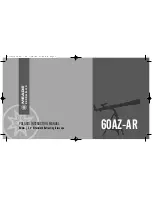
While your telescope requires little maintenance, there are a few things to remember that will ensure your telescope
performs at its best.
C
C
a
a
r
r
e
e
a
a
n
n
d
d
C
C
l
l
e
e
a
a
n
n
i
i
n
n
g
g
o
o
f
f
t
t
h
h
e
e
O
O
p
p
t
t
i
i
c
c
s
s
Occasionally, dust and/or moisture may build up on the objective lens or primary mirror depending on which type of
telescope you have. Special care should be taken when cleaning any instrument so as not to damage the optics.
If dust has built up on the optics, remove it with a brush (made of camel’s hair) or a can of pressurized air. Spray at an
angle to the glass surface for approximately two to four seconds. Then, use an optical cleaning solution and white tissue
paper to remove any remaining debris. Apply the solution to the tissue and then apply the tissue paper to the optics. Low
pressure strokes should go from the center of the lens (or mirror) to the outer portion.
Do NOT rub in circles!
You can use a commercially made lens cleaner or mix your own. A good cleaning solution is isopropyl alcohol mixed
with distilled water. The solution should be 60% isopropyl alcohol and 40% distilled water. Or, liquid dish soap diluted
with water (a couple of drops per one quart of water) can be used.
Occasionally, you may experience dew build-up on the optics of your telescope during an observing session. If you want
to continue observing, the dew must be removed, either with a hair dryer (on low setting) or by pointing the telescope at
the ground until the dew has evaporated.
If moisture condenses on the inside of the optics, remove the accessories from the telescope. Place the telescope in a dust-
free environment and point it down. This will remove the moisture from the telescope tube.
To minimize the need to clean your telescope, replace all lens covers once you have finished using it. Since the cells are
NOT sealed, the covers should be placed over the openings when not in use. This will prevent contaminants from entering
the optical tube.
Internal adjustments and cleaning should be done only by the SPACE GROUP repair department. If your telescope is in need of
internal cleaning, please call the factory for a return authorization number and price quote.
C
C
o
o
l
l
l
l
i
i
m
m
a
a
t
t
i
i
o
o
n
n
o
o
f
f
a
a
N
N
e
e
w
w
t
t
o
o
n
n
i
i
a
a
n
n
The optical performance of most Newtonian reflecting telescopes can be optimized by re-collimating (aligning) the
telescope's optics, as needed. To collimate the telescope simp ly means to bring its optical elements into balance. Poor
collimation will result in optical aberrations and distortions.
Before collimating your telescope, take time to familiarize yourself with all its components. The primary mirror is the
large mirror at the back end of the telescope tube. This mi rror is adjusted by loosening and tightening the three screws,
placed 120 degrees apart, at the end of the telescope tube. The secondary mirror (the small, elliptical mirror under the
focuser, in the front of the tube) also has three adjustment screws (you will need optional tools (described below) to
perform collimation. To determine if your telescope needs collimation first point your telescope toward a bright wall or
blue sky outside.
Aligning the Secondary Mirror
The following describes the procedure for daytime collimation of your telescope using the optional Newtonian
Collimation Tool (#01112, #01119) offered by SPACE ARCADE. To collimate the telescope without the Collimation
Tool, read the following section on night time star collimation.
If you have an eyepiece in the focuser, remove it. Rack the focuser tube in completely, using the focusing knobs, until its
silver tube is no longer visible. You will be looking through the focuser at a reflection of the secondary mirror, projected
from the primary mirror. During this step , ignore the silhouetted reflection from the primary mirror. Insert the collimating
cap into the focuser and look through it. With the focus pulled in all the way, you should be able to see the entire primary
mirror reflected in the secondary mirror. If the primary mirror is not centered in the secondary mirror, adjust the
secondary mirror screws by alternately tightening and loosening them until the periphery of the primary mirror is centered
in your view. DO NOT loosen or tighten the center screw in the secondary mirror support, because it maintains proper
mirror position.
21


























